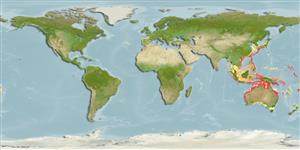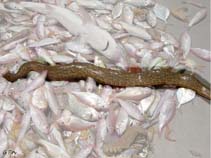Reptilia |
Squamata |
Hydrophiidae
Environment: milieu / climate zone / Mức độ sâu / distribution range
Sinh thái học
Cùng sống ở rạn san hô; Mức độ sâu 3 - 50 m (Tài liệu tham khảo 2352). Tropical; 51°N - 58°S (Tài liệu tham khảo 356)
Indo-Pacific, Northwest Atlantic and the Mediterranean. Tropical and subtropical climates.
Length at first maturity / Bộ gần gũi / Weight / Age
Chín muồi sinh dục: Lm 103.4, range 71 - 130 cm Max length : 200 cm TL con đực/không giới tính; (Tài liệu tham khảo 2357); common length : 150 cm TL con đực/không giới tính; (Tài liệu tham khảo 2357)
Cephalic plates are large, relatively regular (not very fragmented) and symmetrical, with constant partial fragmentation in parietal region. Parietal plates often split in two. Small notches are sometimes visible on the forehead. There often or always seems to be a small median scale between frontal and prefrontal plates in new Caledonian populations. Eyes are separated from supralabials by a row of subocular scales, which are actually larger than the supralabials. Some anterior supralabials that are quite expanded dorso-ventrally can come in direct contact with the eyes. First pair of infralabials touches the posterior part of the mental plate. Midbody body scales (21 to 25 in a row) are smooth and overlapping - these scales have smaller diffuse blunted tubercles. Ventral scales (135 to 155 scales) are much wider than adjacent scales. They are slightly imbricate posteriorly with a median keel that is not always visible. Anal keel is divided, with a relatively prominent keel on each half (Ref. 2357, 2355). Has highly variable coloration and patterns. Adults are commonly solid grey to olive grey with small orangey-brown area in the anterior head region. Juveniles are greyish brown with fine ring-shaped vertical white undulated barring. Anterior orangey brown area is visible at birth. Body coloration turns from brown to predominantly grey and the rings gradually fade with age. Several creamy white or darkly spotted scales are scattered over the body. Brown body scales are often dark in the middle, giving rise to faint longitudinal streaks. Tail is brown or relatively pale and uniform in color (Ref. 2352). Fangs may be 0.7 cm long (Ref. 88063).
Maximum and common lengths also from Ref. 2352. Found along seabeds but prefers coral reefs and can rarely be observed in outer reef slopes (Ref. 2353). It is a generalist feeder, swallowing prey found near the seabed (Ref. 2360) and feeds on several species of reef fish in size range, 3 to 15 cm, including small snappers (Lutjanus lutjanus and Lutjanus kasmira), catfish (Plotosus lineatus), red-barred shrimp (possibly Stenopus hispidus). Especially active at night and tends to attack anything bright and moving. It is a relatively curious and unaggressive snake but can be dangerous (Ref. 2352). Females are larger than males and are potentially more dangerous because of higher venom yield (Ref. 2359). Preyed upon by tiger sharks (Galeocerdo cuvier).
Life cycle and mating behavior
Chín muồi sinh dục | Sự tái sinh sản | Đẻ trứng | Eggs | Sự sinh sản | Larvae
Females are larger than males (Ref. 2359). Australia: It is a viviparous snake, which bears 1 to 5 large offspring, with an average of 3 offspring (Ref. 2357, 2355). Gestation period is around 9 months and only 50% of females seem to be gravid at the same time (biennial reproduction), suggesting that a full year is required for adipose tissue renewal (Ref. 2361). Reproduces throughout the year. One or even more males with frenzied appearance than usual start protruding and retracting their tongues very rapidly every time they meet. Become more frenzied when they encounter a receptive female, which also protrudes and retracts its tongue. Chosen male and receptive female coil and uncoil together. During mating, couple completely wraps and coils together while male hits the female's nape several times with its head (Ref. 2352).
Ineich, I. and P. Laboute 2002 Sea snakes of New Caledonia. IRD Éditions. Institut de Recherche pour le Développement. Muséum national d'histoire naturelle. Collection Faune et flore tropicales. 39:302 pp. (Tài liệu tham khảo 2352)
IUCN Red List Status
(Tài liệu tham khảo 130435: Version 2025-1)
CITES status (Tài liệu tham khảo 108899)
Not Evaluated
CMS (Tài liệu tham khảo 116361)
Not Evaluated
Threat to humans
Human uses
| FishSource |
Các công cụ
Thêm thông tin
PhysiologyThành phần ô-xy
Human RelatedStamps, coins, misc.
Các nguồn internet
Estimates based on models
Preferred temperature
(Ref.
115969): 23 - 28.8, mean 27.4 (based on 608 cells).
Thích nghi nhanh
Chiêù cao, thời gian nhân đôi của chủng quần tối thiểu là dưới 15 tháng (K=0.38).
Fishing Vulnerability
High to very high vulnerability (69 of 100).
Price category
Unknown.




